With over 2.5 billion monthly users, YouTube is one of the best social platforms to share videos, connect with people, and grow your brand or channel.
Whether you’re a creator, a business, or just someone with a story to tell, YouTube gives you the chance to reach a massive audience.
But let’s face it—just uploading videos isn’t enough.
If you want your channel to grow, you need the right strategies to help people discover your content, keep them engaged, and make them want to come back for more.
In this guide, we’ll share 15 tips on how to grow YouTube channel:
1. Understand the YouTube Algorithm
YouTube’s recommendation algorithm influences a solid 70% of what people watch on the platform.
It’s no wonder marketers, creators, and influencers are so eager to crack the code and figure out how it works.
So, how exactly does it work?
While it has evolved over the years, the current system focuses on these key factors:
- Relevance: YouTube analyzes things like titles, tags, descriptions, and content to match videos to your search query.
- Engagement: Metrics like watch time, watch percentage, likes, comments, and shares help the algorithm decide what’s popular.
- Quality: Signals are used to gauge a channel’s authority and trustworthiness on a particular topic.
- User search and watch history: Your past viewing and search habits shape the recommendations YouTube thinks you’ll find helpful.
These factors are weighted differently depending on where you’re getting recommendations—your homepage, search results, or suggested videos.
The YouTube Shorts Algorithm
One of the latest additions to the YouTube family is YouTube Shorts. According to Todd Sherman, the product lead for Shorts, the Shorts algorithm operates differently from the standard YouTube algorithm.
Instead of viewers actively choosing videos to watch, they swipe through a feed of content. This means the algorithm focuses on variety to keep users entertained and engaged.
Here’s a quick breakdown of what the Shorts algorithm prioritizes:
- Relevance: Does the title, tags, description, and content align with the search term?
- Engagement: Are people liking and commenting on the video?
- User watch history: What types of videos have the viewer enjoyed in the past?
- Similar content: What other Shorts are popular with similar audiences?
- Watch time: While not as crucial as for regular videos, skipping through a 15-second video signals low engagement.
When it comes to Shorts, YouTube has clarified that timing and the number of uploads don’t matter as much as the quality of content.
YouTubers should create engaging, original Shorts that resonate with your audience.
It’s also worth noting that deleting and reposting Shorts repeatedly is discouraged, as it can be flagged as spammy behavior.
2. Optimize Your Channel
Set your YouTube channel up for success by fully optimizing your profile from the very beginning.
Even if your subscriber count is small (in single or double digits), looking professional and established can make a big difference in attracting new viewers.
Here are all important elements you’ll need to include:
- Profile Photo: For creators, this should be a professional headshot; for brands, use a clear and recognizable logo.
- Channel Art: Design a banner that showcases your channel’s theme and tells viewers what to expect.
- Video Watermark: Add a subtle watermark (like your logo) to all your videos for branding and recognition.
- Channel Description: Write a brief, engaging overview of your channel. Highlight what type of content you’ll post and how it benefits your audience.
- Links/Contact Info: Include links to your social media, website, and email address to make it easy for viewers to connect with you.
- Featured Video: Pin an introductory video at the top of your channel to welcome new visitors and give them a taste of your content.
- Channel Verification: Get your channel verified to boost credibility and help establish trust with your audience.
You can make all these updates in the Channel Customization section of YouTube Studio.
Taking the time to fill out these details helps potential subscribers quickly understand what your channel offers and why they should stick around.
A fully optimized channel not only looks more professional but also feels more inviting to viewers.
Here’s an example of a fully optimized channel:
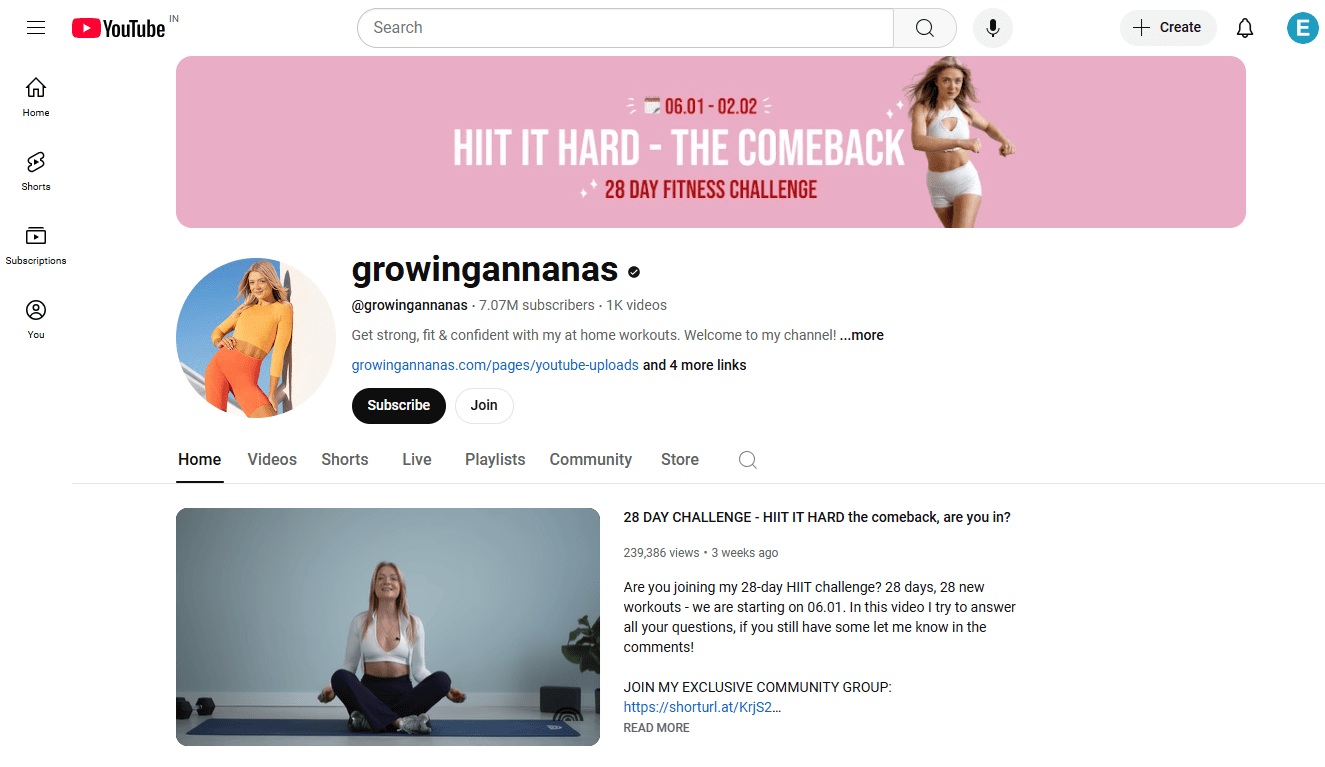
3. Figure Out What Your Audience Wants
When creating content for your channel, it’s important to align it with what your audience wants.
Whether it’s a video or a blog post, the key to success is understanding your viewers’ preferences and delivering content that relates with them.
If you’re just starting out, studying your competitors or other creators in your niche is a great way to gather insights. Pay attention to which of their videos get the most views and engagement.
This can give you a clear idea of the topics your audience is interested in and the video styles they enjoy.
Tools like Keywords Everywhere make this process even easier. Simply install and activate the browser extension, then head over to a competitor’s channel.
For example, if you create craft videos and your competitor is INNOVA Crafts, go to their channel and click on a video.
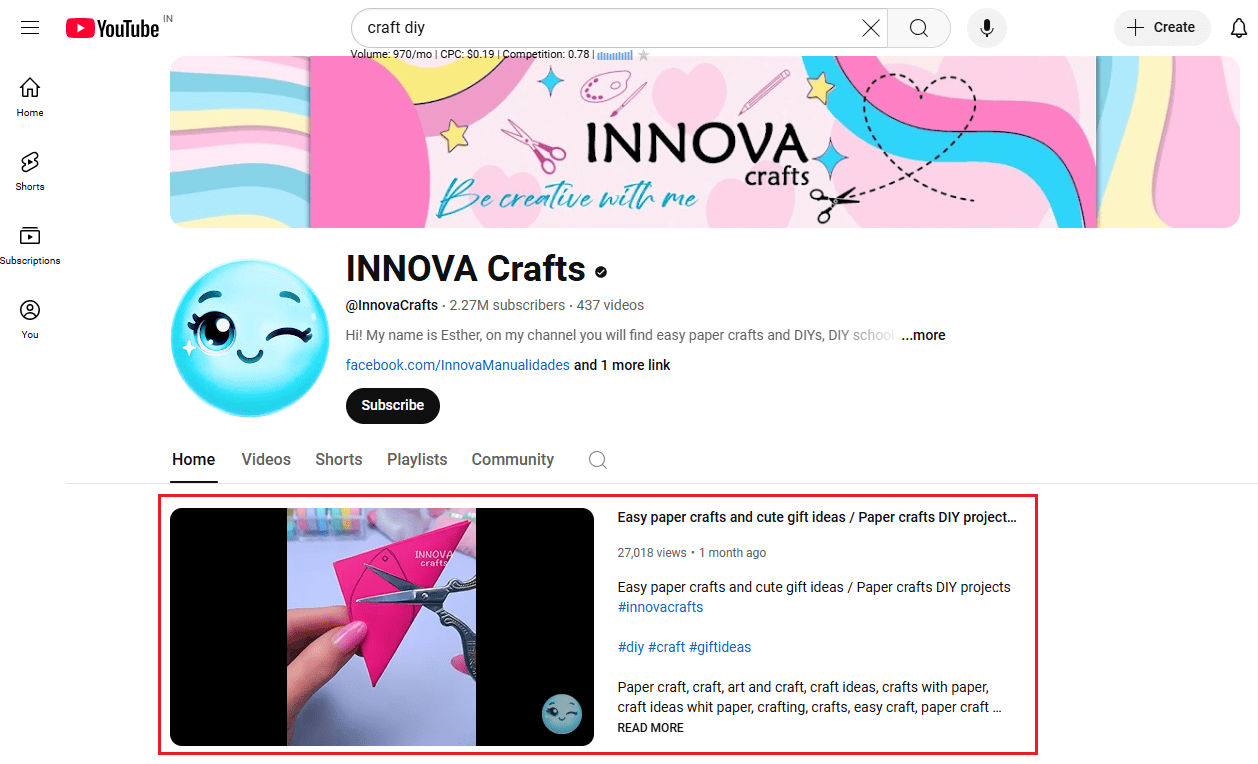
On the top right corner of your screen, you’ll see a widget displaying important metrics such as views per day, optimization score, and engagement score.
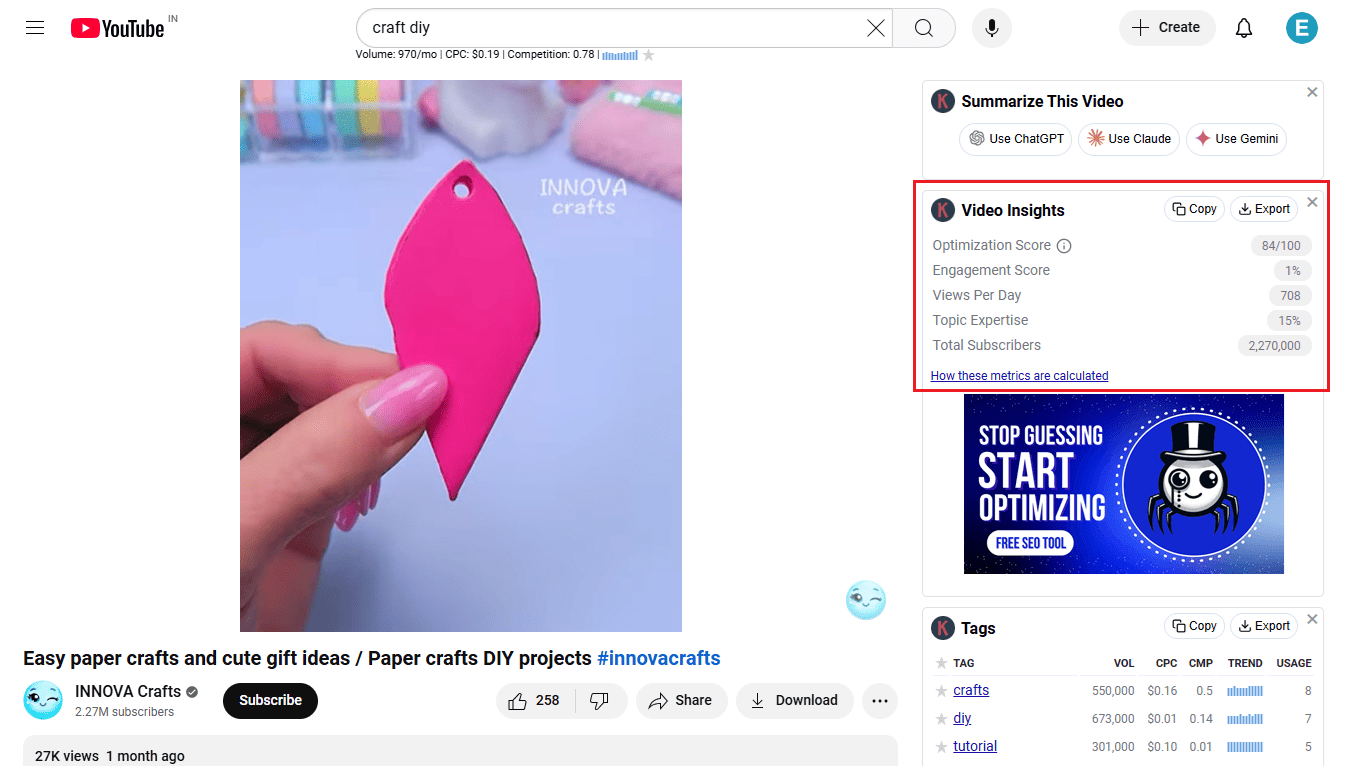
By looking at metrics like views and engagement scores, you’ll understand what kind of content your target audience wants to see and what style of videos they prefer (long form/short form).
This way, you can grow your channel and surpass your competitors.
4. Build Videos Around a Single Keyword/Topic
Marketers who aren’t familiar with Search Engine Optimization (SEO) risk missing out on the opportunity to rank their videos and reach a wider audience.
If you want your videos to get maximum visibility and attract more viewers, mastering SEO is a must.
The key to bringing traffic and growing your YouTube audience is building your videos around a single, focused topic or keyword.
The problem? Finding the right keywords to target.
Many free keyword research tools are available to help you find the most relevant keywords for your brand and audience.
Keywords Everywhere can help you pinpoint the best keywords for your topic and do complete keyword research for YouTube keywords.
Once you’ve identified your keywords, use an SEO toolkit to integrate them into your content strategy across all platforms (e.g., your blog, website, or social media).
Make sure to naturally include your keywords throughout your video’s content so that YouTube’s algorithm picks them up, especially when closed captions are added.
Don’t forget to optimize your video title and description with your keywords for better visibility.
5. Watch Your Video Length
There’s been a growing trend toward making longer YouTube videos in recent years.
The reason? To increase watch time.
Since watch time is one of the most important ranking factors on YouTube, creators aim to keep viewers watching for as long as possible—hence, longer videos.
So, what’s the ideal length for YouTube videos?
We recommend aiming for a length between 8-12 minutes. But remember, don’t stretch your video just to make it longer.
Making your video unnecessarily long can hurt your channel. Viewers don’t want to sit through unnecessary filler—they’re looking for a solution to their problem.
If your video is packed with fluff, viewers will drop off, leading to poor audience retention, which directly impacts your rankings.
Worse yet, if your video doesn’t hold their attention, YouTube might not even recommend it.
Additionally, avoid dragging the solution to the end of the video. If viewers have to sit through the fluff in the intro before they get to the “meat” of the content, they’re likely to leave early, causing further harm to your retention and rankings.
For the best balance between engagement and revenue, aim for a video that’s at least 8 minutes long.
This gives you the chance to include mid-roll ads, which can boost your earnings.
However, always focus on delivering valuable, concise content first, and don’t lengthen your video just for the sake of it.
6. Engage with Your Audience
It’s crucial to remember that YouTube is not just a video platform—it’s a social media channel that thrives on interaction.
If you’re posting videos without encouraging comments or conversation, you’re missing out on a big opportunity to boost your channel’s engagement.
YouTube rewards channels that have high engagement, including watch time, likes, dislikes, and most importantly, comments.
So, take the time to respond to as many comments as you can (when possible!) and guide your viewers to engage with your content by using audio and visual prompts.
Don’t forget you can also engage with other creators on the platform.
Whether it’s a brand in your niche, a competitor, or a channel you admire, interacting with others can help boost your visibility and create opportunities for cross-promotion.
And don’t just wait for your audience to engage—take the lead by asking questions related to your content or simply asking what kind of videos they’d like to see more of on your channel.
When people do engage, always remember to thank them—whether it’s for sharing your content on YouTube or other platforms.
Here’s what your comment section will look like if you engage with your audience daily:
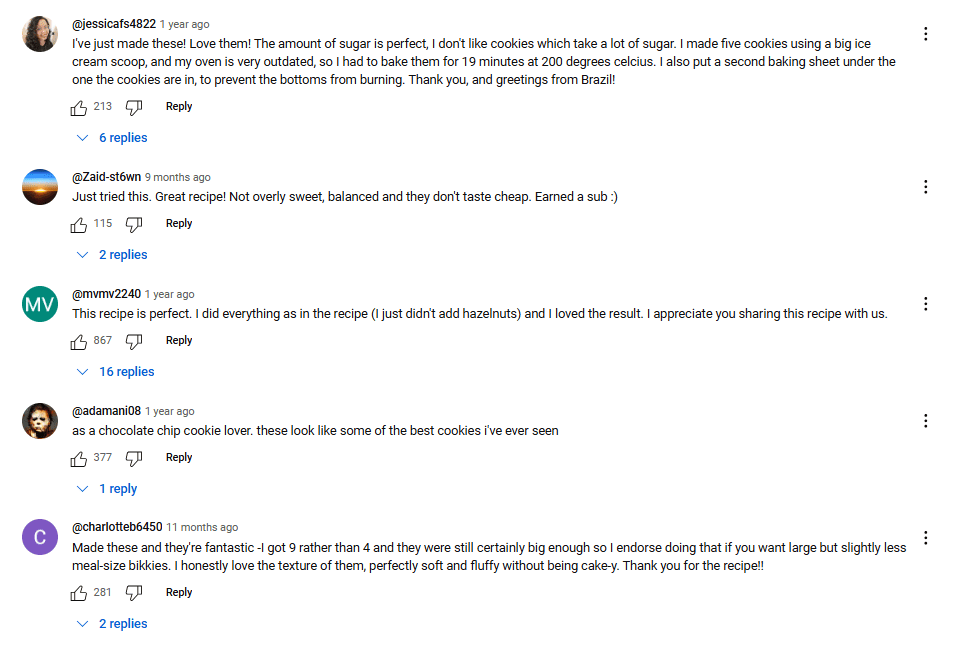
7. Be Consistent with Content and Regular Posting
If you want to grow your YouTube channel, consistency is key. This means setting a realistic posting schedule and sticking to it.
A common approach is posting once a week, but it’s important to choose a schedule that you can realistically manage.
When you’re just starting out, creating and editing videos can take time, and that’s okay.
Creator burnout is a real issue, which is why consistency is more important than frequency. If you can only manage one video every two weeks, that’s perfectly fine.
The important thing is that you’re posting regularly and not neglecting your channel. As long as you stay active, your channel can grow.
You can use Keywords Everywhere’s ChatGPT prompt for YouTube, which allows you to create a content calendar for the next three months.
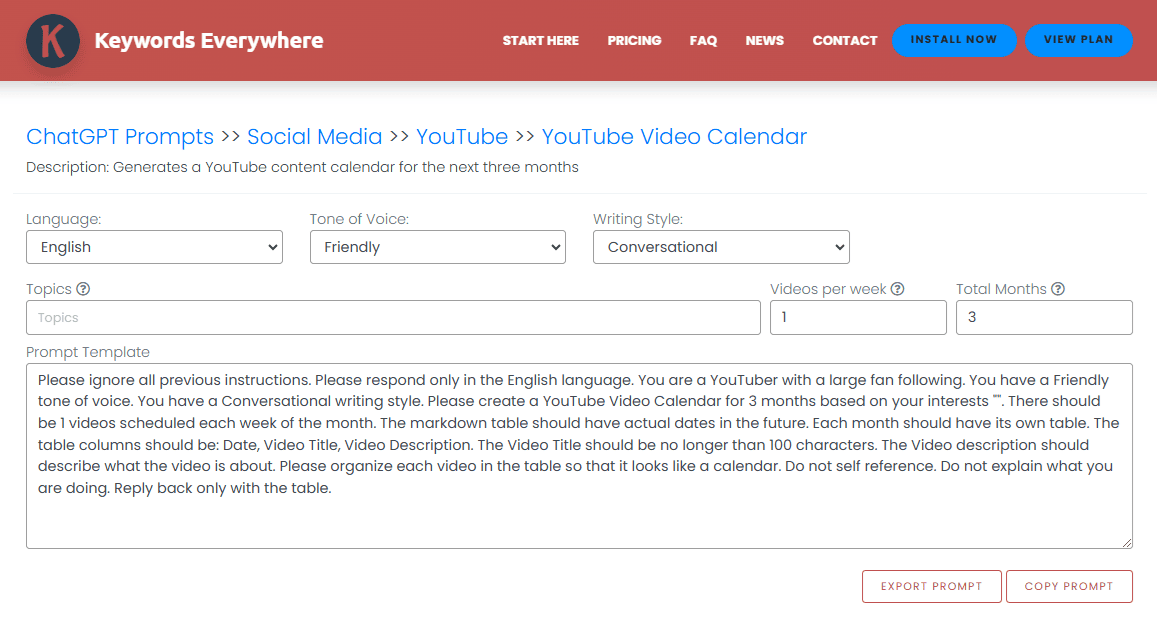
This way, you will stay organized, keep everything out of your head, and ensure you’re consistently planning and tracking your content.
8. Collaborate with Fellow Creators and Brands
A fantastic way to expand your reach is by collaborating with other YouTubers.
When you’re featured or mentioned on another channel, you’re instantly introduced to a whole new audience, which can help you attract potential subscribers.
Look for a channel that creates content similar to yours (though, if you’re a brand, it’s best to avoid direct competitors and instead collaborate with creators or complementary brands). Reach out and pitch the idea of a partnership.
You could create a joint video (or even two—one for each channel) and use it as an opportunity to promote each other’s YouTube channels.
Even the biggest names on YouTube, like MrBeast and T-Series, found value in collaboration.
After months of rivalry, they ended their competition with a fun collaboration. MrBeast proposed a subscription exchange, and T-Series’ Chairman Bhushan Kumar agreed.
This playful exchange not only shifted their relationship from competition to collaboration but also sparked excitement among their millions of fans.
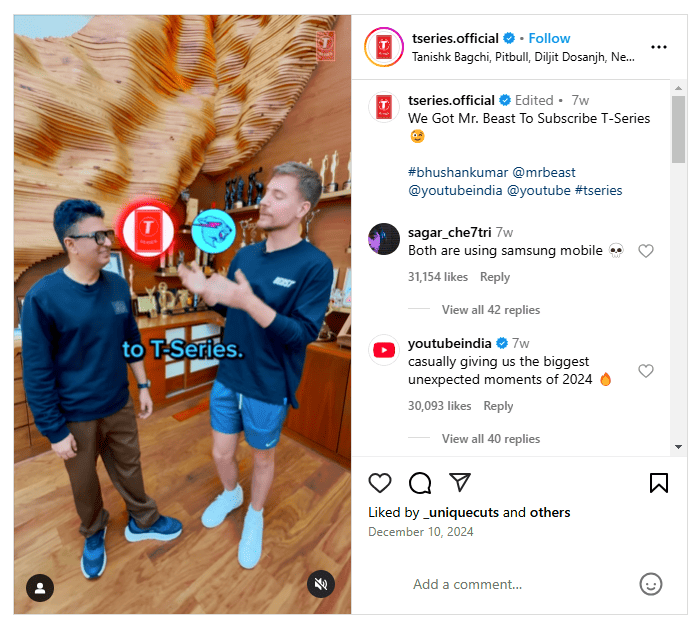
If these YouTube giants can team up, so can you!
9. Rank in Google Video Search
Google, as the largest search engine, plays a significant role in determining who sees your content.
That’s why optimizing your videos to rank in Google search is a must if you want to maximize your visibility.
So, how can you get your videos to rank on Google?
The key is SEO—targeting the right keywords and optimizing your video titles, descriptions, and content to match search intent.
It all comes down to creating videos that align with what people are searching for. You can use tools like Keywords Everywhere to uncover relevant and popular topics.
For instance, if you’re a backflip instructor and type in “How to do a backflip,” you’ll see YouTube videos dominating the search results.
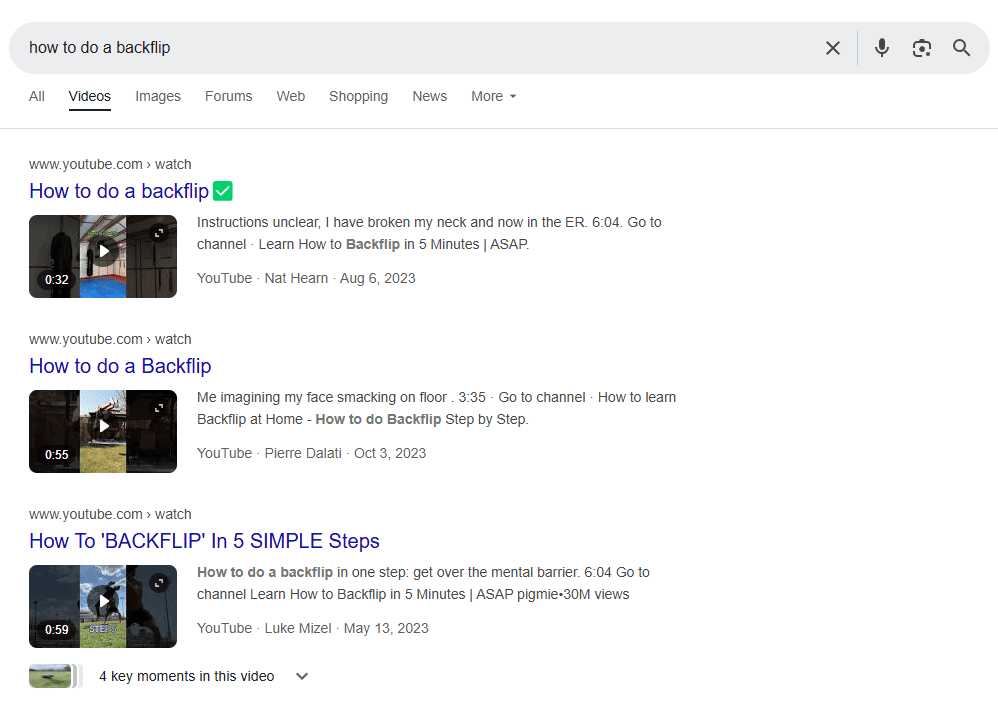
Even when you go to Google’s main search page, the first result is a YouTube video teaching how to do backflip.
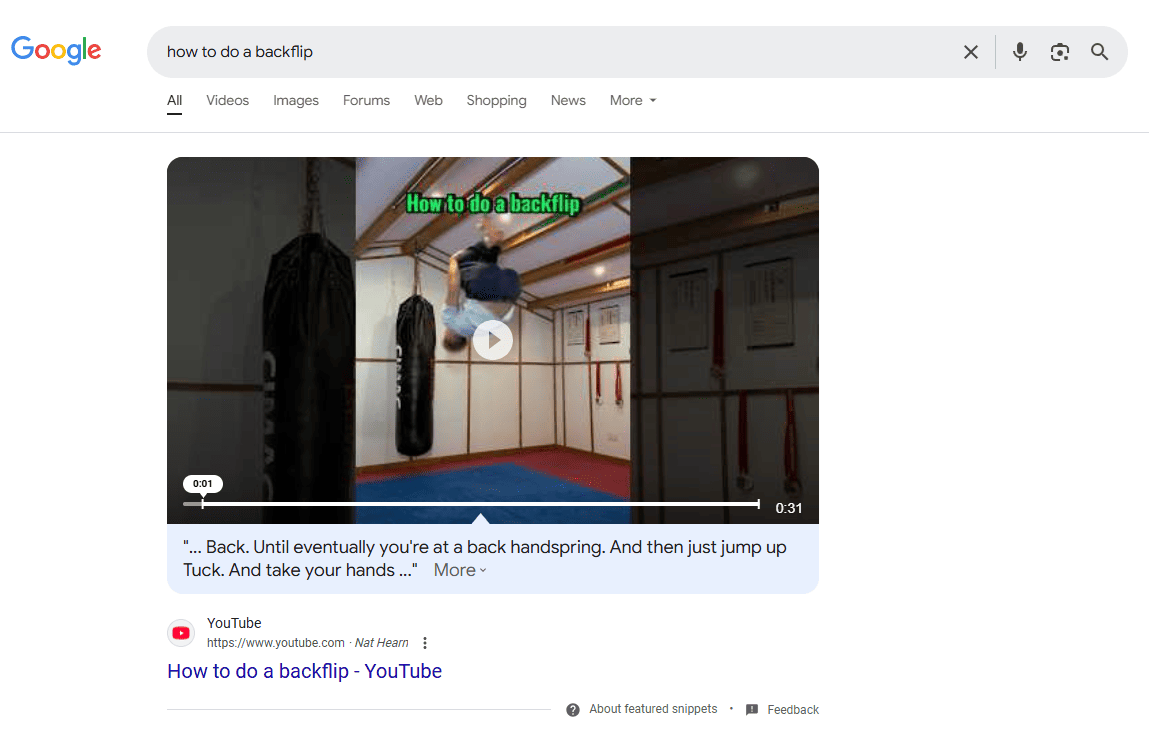
This shows how powerful the combination of SEO and video content can be.
Additionally, Google sometimes displays timestamps as “key moments” for videos in search results. Including timestamps in your videos can make them more user-friendly and boost their visibility in search results.
Experiment with adding them to some of your top-performing videos to see the impact.
Another way to improve rankings is by embedding your YouTube videos on relevant web pages or blog posts.
This helps generate backlinks, which Google sees as a trust signal, potentially improving your video’s ranking.
10. Promote YouTube Videos on Other Social Channels
One of the best things about social media is the ability to cross-promote content across multiple platforms.
Sharing your YouTube videos on other social channels is one of the easiest ways to grow your audience and increase visibility.
According to GWI data, the average social media user actively engages with about 6.8 different platforms each month, spending about 2 hours and 19 minutes daily on social media.
Datareportal also highlights that over 70% of YouTube users also use platforms like Facebook, WhatsApp, and Instagram, while over 40% are active on TikTok, Telegram, and Twitter (X).
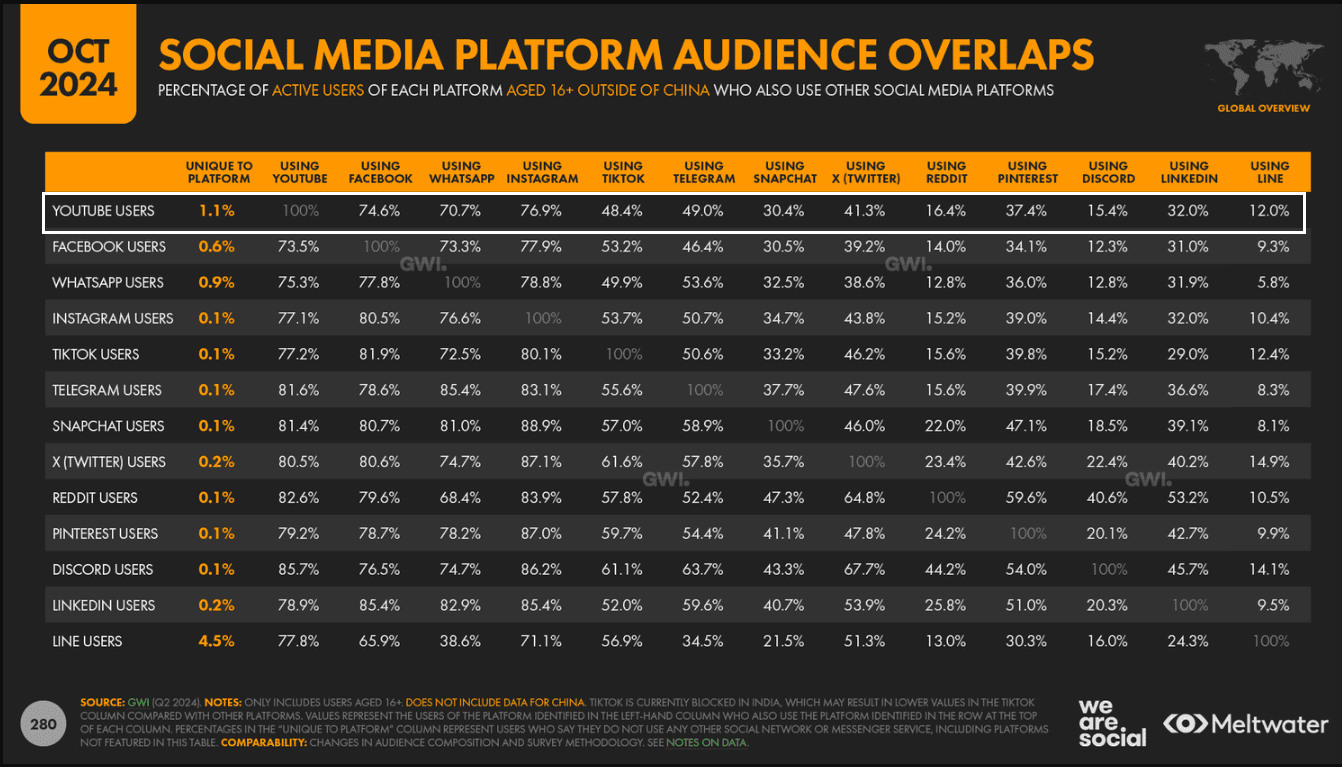
Social media platform audience overlaps
This overlap makes it important to use other social channels to drive engagement and expand your reach.
So, take a moment to consider—what platforms are you already active on? Facebook, LinkedIn, X, Instagram, TikTok?
There’s no shortage of options, and each platform offers unique opportunities to engage your audience.
If you’re sharing content on a platform like Instagram or TikTok, you can create teasers or short clips from your YouTube videos.
These can entice viewers to check out the full-length video on YouTube, ensuring you optimize engagement across all your social channels.
11. Invest in YouTube Ads
With marketing becoming more of a pay-to-play game, running paid YouTube ads is a great way to boost your visibility and grow your channel.
YouTube offers several ad formats to suit different campaign goals:
- Display ads: Appear on the right-hand sidebar of videos, but only on desktop.
- Overlay ads: Semi-transparent ads that show up at the bottom of a video (desktop-only).
- Skippable and non-skippable video ads: These can appear before, during, or after a video. Skippable ads let viewers skip after five seconds, while non-skippable ads must be fully watched.
- Bumper ads: Short, non-skippable ads (up to six seconds) that play before the video content.
- Sponsored cards: Small cards displayed within relevant videos, perfect for promoting products or related content.
For your ad creatives, you have only these two options:
1. Use an existing video: If a video has already performed well organically, it’s a solid candidate for ads. Paid promotions can amplify your reach and results.
2. Create a new video: Now, when you make something new, you can design content specifically tailored to your campaign goals. This gives you better control over the message and targeting.
Both approaches can be effective. It’s all about balancing creativity with what works best for your audience and your campaign objectives.
12. Create Playlists to Organize Your YouTube Content
The more videos you upload, the harder it gets for viewers to find what they’re looking for on your channel.
That’s where playlists come in handy.
They not only help you organize your content into categories but also encourage viewers to binge-watch related videos.
For instance, take National Geographic’s YouTube channel. With hundreds of videos on topics like wildlife, the environment, and space, they use playlists to guide their audience to whatever content they want to see.
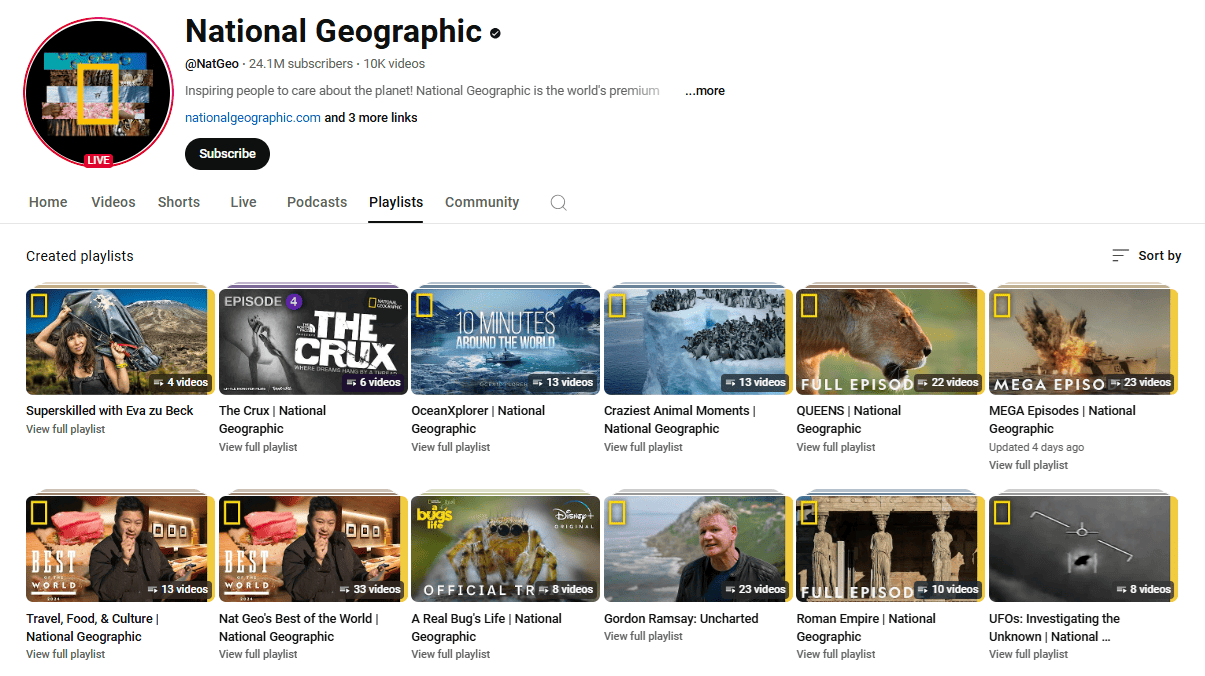
This way, viewers don’t have to go through everything—they can jump straight into the content that interests them most.
13. Schedule Live Streams for Faster Growth
YouTube Live is one of the most dynamic features on the platform, offering creators, businesses, and individuals the chance to connect with their audiences in real-time.
With just a click of the “Live” button on YouTube, you can explore all the channels broadcasting live at that moment.
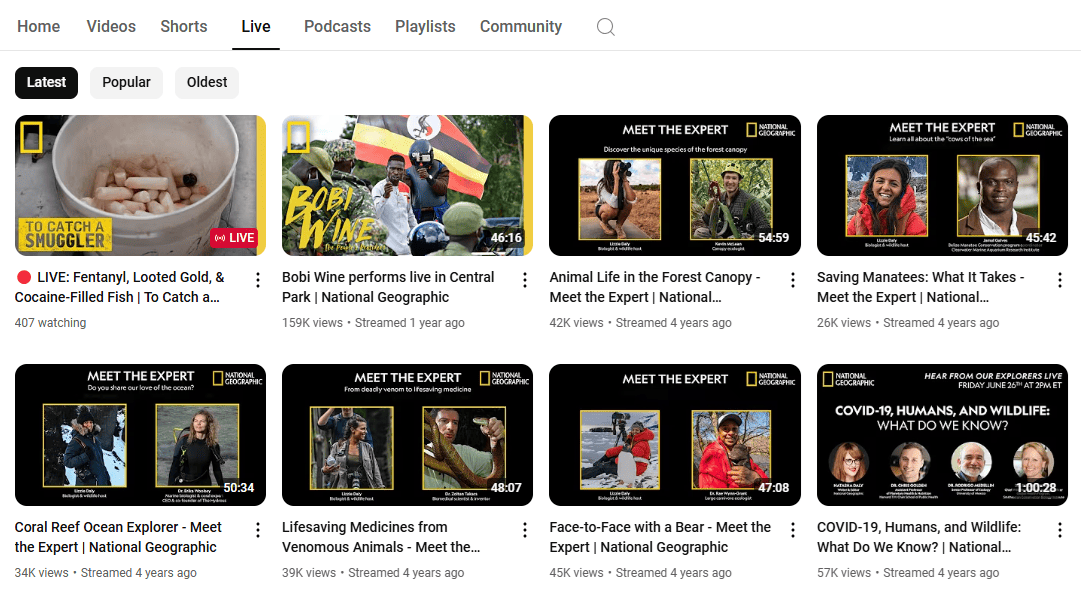
But why should you use YouTube Live? Here are some stats to convince you:
- Over 35% of social media marketers use live video as part of their strategy.
- Around 45% of consumers want to see more live videos from their favorite brands.
- Nearly 37% of social media users consider live video the most engaging content.
- Many YouTube channels report earning over $3 million through live streams using features like YouTube Super Chat.
If these numbers don’t spark your interest, what will?
You can try several options like webinars, Q&A sessions, live tutorials, or product demonstrations for your live stream.
And don’t worry if your first few streams feel less polished than your regular videos. That’s the magic of live video—its raw, unfiltered, and authentic vibe keeps viewers coming back for more.
Remember, part of the appeal is that anything can happen.
14. Maximize Views with YouTube Shorts
Back in September 2020, YouTube introduced YouTube Shorts, its answer to short-form, vertical videos—similar to TikTok or Instagram Reels.
These bite-sized videos are showcased in a dedicated Shorts section, where users can swipe through them endlessly.
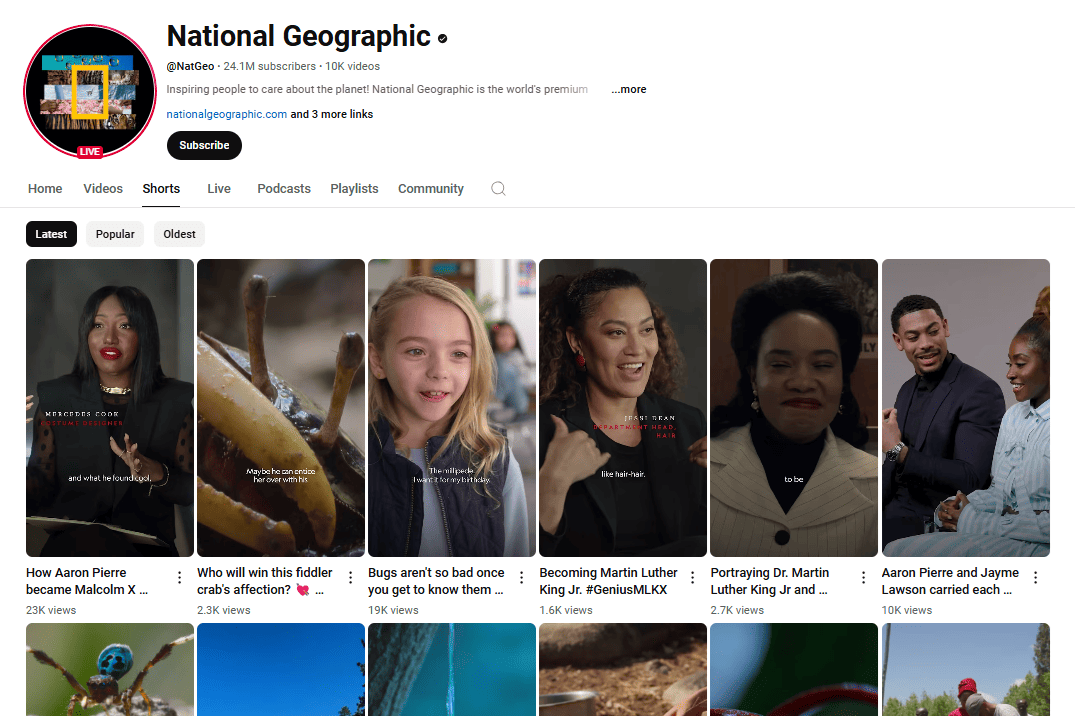
Fast forward to today, and YouTube Shorts has become a massive hit.
According to Google’s Q1 2024 earnings call, YouTube Shorts now racks up over 70 billion daily views.
Let that sink in—if each video is roughly 30 seconds long, that translates to 2.1 trillion minutes of watch time every day or nearly 4 million years.
These stats prove one thing: Shorts are essential for growing your channel, especially if you’re starting out.
Take a 15-second snippet from your latest video and upload it as a Short. Or better yet, as you’re editing your videos, pull out a few interesting moments and create 2 to 3 Shorts to post throughout the week.
It’s a quick, easy way to maximize visibility and get more eyes on your content.
15. Monetize Your Channel
Once your YouTube channel starts gaining traction, why not turn your passion into profit? YouTube offers a fantastic monetization plan, with the average creator earning nearly $5,000 a month.
This means YouTube can become a lucrative side hustle—or even replace your full-time job—if you stay consistent and build a loyal following.
To start making money, you need to join the YouTube Partner Program (YPP). Here’s what you’ll need to qualify:
- Follow YouTube’s channel monetization policies.
- Live in an eligible country/region.
- Comply with community guidelines.
- Enable 2-step verification.
- Unlock advanced features (requires additional verification).
- Link an active AdSense account to your channel.
- Have at least 1,000 subscribers.
- Achieve either 4,000 valid public watch hours in the last 12 months or get 10 million valid public Shorts views in previous 90 days.
Once you meet all the above points, you can apply to the YouTube Partner Program. Once approved, you’ll start earning revenue from ads shown on your videos—turning your hard work into a rewarding income stream.
Conclusion
Growing your YouTube channel takes effort, creativity, and consistency. Start by optimizing your profile, creating valuable content, and engaging with your audience.
Focus on quality over quantity, and always keep your viewers’ interests in mind. You can try out different options like YouTube Shorts, Live, or long videos and see what’s working for you.
Regularly monitor your channel and make adjustments from time to time.
Also, to simplify the process, you can use our tool—Keywords Everywhere.
We provide useful insights into keywords, trends, and search intent. All of it can help you create content that relates to your audience and ranks higher on YouTube and Google.


